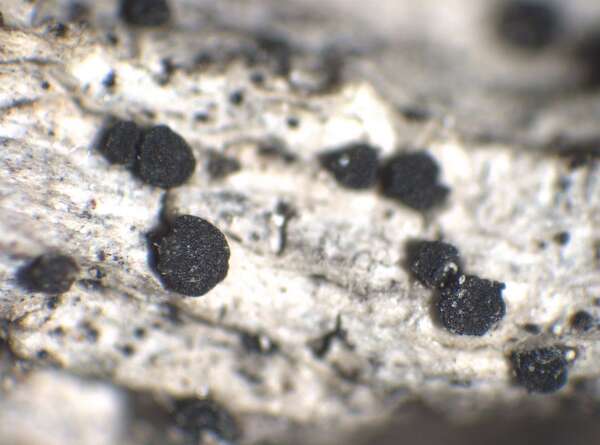Bactrospora patellarioides var. convexa (B. de Lesd.) Egea & Torrente
Lichenologist, 25: 249, 1993. Basionym: Lecanactis patellarioides var. convexa B. de Lesd. - Bull. Soc. Bot. France, 20: 281, 1922.
Synonyms: Raphiospora doriae Bagl.
Distribution: N - Lig (Watson 2014). C - Tosc (Loppi & al. 1997c, 1999a, 2004c, Putortì & Loppi 1999, Senese & Critelli 2000), Sar (Jatta 1909-1911). S - Pugl (Nimis & Tretiach 1999), Cal (Puntillo 1996).
Description: Thallus crustose, episubstratic, continuous to rimose, white, creamy white or pale brownish grey, smooth to farinose, ecorticate, with a thick epinecral layer filled with crystals, sometimes delimited by a thin dark prothallus. Apothecia lecideine, black, adnate, usually not constricted at base, round to slightly irregular in outline, 0.2-0.4(-0.6) mm across, with a flat to usually convex, epruinose disc, and a thin, smooth, soon excluded proper margin. Proper exciple dark orange brown to dark brown, usually extending below the hymenium (rarely open), up to 80 µm thick at base; epithecium dark reddish brown, granulose, I+ blue; hymenium colourless to pale brown, (65-)110-170 µm high, I+ pale red, K/I+ pale blue; paraphysoids richly branched and anastomosing in upper part, not coherent, c. 1.5 µm thick at base, the apical cells up to 4 µm wide; subhymenium pale to dark brown, I+ reddish or deep blue, K/I+ deep blue. Asci (6-)8-spored, clavate to subcylindrical, the wall slightly thickened at top at maturity, I+ yellowish brown, the apical dome K/I+ blue, with a K/I- central area. Ascospores 9-17(-25)-septate, acicular or cylindrical, straight or slightly curved, (42-)60-120 x 2-3.5(-5) µm. Pycnidia semi-immersed, the wall brown in upper part, colourless at base. Conidia cylindrical, slightly curved, 13-17 x c. 1 µm. Photobiont trentepohlioid. Spot tests: thallus K-, KC-, C-, P-, UV-. Chemistry: without lichen substances.Note: most frequent in Tyrrhenian Italy, especially on Olea. I am not sure whether this variety is worthy of any taxonomic recognition.
Growth form: Crustose
Substrata: bark
Photobiont: Trentepohlia
Reproductive strategy: mainly sexual
Most common in areas with a humid-warm climate (e.g. most of Tyrrenian Italy)
In underhangs rarely wetted by rain
Commonnes-rarity: (info)
Alpine belt: absent
Subalpine belt: absent
Oromediterranean belt: absent
Montane belt: absent
Submediterranean belt: absent
Padanian area: absent
Humid submediterranean belt: absent
Humid mediterranean belt: rather rare
Dry mediterranean belt: absent

Predictive model
Herbarium samples
Growth form: Crustose
Substrata: bark
Photobiont: Trentepohlia
Reproductive strategy: mainly sexual
Most common in areas with a humid-warm climate (e.g. most of Tyrrenian Italy)
In underhangs rarely wetted by rain
Commonnes-rarity: (info)
Alpine belt: absent
Subalpine belt: absent
Oromediterranean belt: absent
Montane belt: absent
Submediterranean belt: absent
Padanian area: absent
Humid submediterranean belt: absent
Humid mediterranean belt: rather rare
Dry mediterranean belt: absent

Predictive model
| Herbarium samples |
 Index Fungorum
Index Fungorum
 GBIF
GBIF



